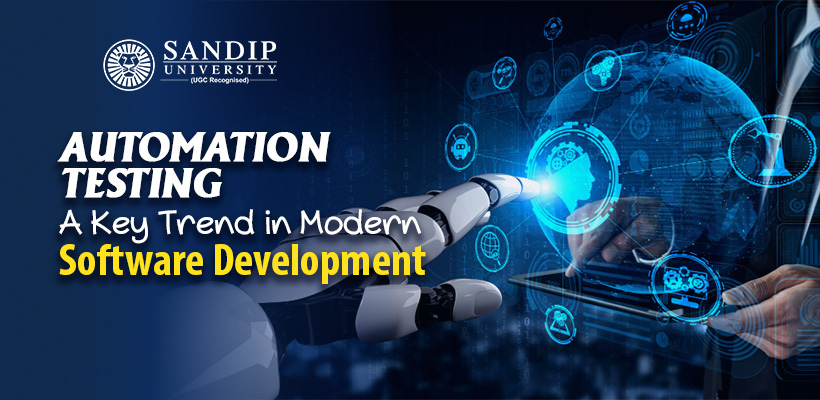Automation testing has assumed one of the most key aspects in the software development environment. In the past few years or so, the world has witnessed increasing demand for faster, good, and efficient delivery processes, incrementing requests for strong and reliable testing techniques. Many top computer engineering colleges in Nashik offer cutting-edge programs to provide the industry with competent and highly skilled professionals in this field.
Automation testing seems to have risen to the occasion, offering scalable solutions for complicated quality assurance problems. So, what is really behind this trend, and why is it more relevant than ever? Let us find out!
An Increasing Demand for Automation Testing
- Accelerated Release Cycle
Automation testing is fast becoming a must-have in view of the increased demands for faster software release cycles, driven mainly by agile methodologies and DevOps practices. Rapid iterations require constant feedback from the developers, and automated tests fit perfectly in that process. Automation enables managers to run repetitive tests with high speed, letting teams validate code with every change and ensure that software is free of bugs while expediting release cycles.
- Increased Complexity in Software
As applications keep increasing in complexity, manual testing becomes more inefficient. With the advent of cloud-based applications, microservices, and cross-platform compatibility, testing has become a much more complex affair. If scaling is required to manage the complexity associated with modern software development, it is automated testing that comes in to offer that support. From the various testing processes, APIs, UIs, and performance test automation ensures that whatever aspect of an application can be reliably and consistently checked.
- Long-term Cost-effective Testing
Automation testing may require huge investments in automation testing tools and the development of automation scripts. However, it offers great long-term benefits as the benefits far outweigh this hefty price. Automated tests would decrease the repeated effort of manual testing, allowing testers to concentrate on more complex and exploratory testing tasks. Catching bugs early in the development cycle with automation testing prevents bugs from becoming expensive; usually, fixing a bug is much more expensive if it is caught later in production.
What Drives the Trend of Automation Testing?
- Advancement in Artificial Intelligence
AI is taking automation testing to the next level. Machine learning algorithms are being installed in testing tools to predict bugs, optimise test coverage, and even suggest test cases. These intelligent systems can recognise patterns of application behaviour and dynamically adjust testing strategies. This intelligent approach has significantly reduced the need for manual intervention and rendered automation smarter and more efficient.
- DevOps and Continuous Integration
Today, continuous integration and continuous delivery have become rudimentary essentials in the DevOps universe. Fast and reliable testing that assures that new code does not break existing functionality is the cornerstone of a successful CI/CD process. Automation testing comes in strongly here as it integrates with CI tools like Jenkins or Travis CI to automatically run tests whenever new code is pushed to the repository. This helps maintain the application stability and to accelerate the software development life cycle.
- Cloud and Cross-platform Testing
With the increase in cloud-native apps, the cross-platform testing scenario is increasingly becoming a challenge. Automated testing tools provide cloud-based environments to simulate different devices, browsers, and operating systems, allowing companies to test their software on different platforms without physically owning these devices. This condition has fast-tracked automation in cross-platform testing scenarios, which would usually be painstakingly tedious and prone to errors if carried out manually.
- Shift Left Testing
The growth of automation testing is being heavily influenced by the trend of Shift Left Testing. Shift-left refers to the practice of beginning testing early in the software development life cycle, ideally at unit testing and integration testing. By spotting and fixing bugs at an early stage, teams can reduce the occurrence of defects that would otherwise reach production. Automated tests can easily be integrated into the CI/CD pipeline and executed automatically at each phase for faster feedback to developers.
The Future of Automation Testing
Automation testing will continue to evolve and expand in parallel with the newest technologies. Some of the most thrilling trends to keep an eye out for in the near future include:
- AI-Powered Testing
With the increase in the advancement of AI and ML technologies, automation tools will become smarter. Such tools will hopefully be able to detect issues on their own, suggest fixes to those issues, and even optimise test suites for better performance. Expect more intelligent and self-sustaining testing.
- Automation for Low-Code/No-Code Development
With the rise in demand for low-code and no-code platforms, there will be a contrasting rise in demand for WYSIWYG automation testing tools that automate the testing.
Conclusion
Automation testing is only going to increase in coming years as per many studies in the field. Some of the best computer science colleges in Maharashtra can take the lead in including topics and skill-building activities in this field to facilitate further innovation in this field. If you are looking for a futuristic career with a global reach, then computer engineering can help you achieve your career goals!

